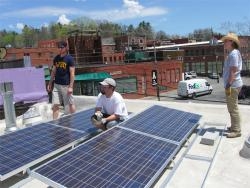Community Solar: A New Model for Local Ownership?
by John Farrell, New Rules Project

Minnesota, United States -- A new report by the Institute for Local Self-Reliance (ILSR), Community Solar Power: Obstacles and Opportunities, examines nine community solar projects, the policies that made them possible, and the substantial barriers that remain.
Successful community solar power projects in Colorado, Maryland, and North Carolina are knocking down the price of residential-scale solar photovoltaics (PV) by 25% and giving opportunities to renters and people with shady roofs a chance to go solar.
However, while ILSR’s report found some successful community solar business models, there are others that lead to little or no ownership, as well as others that defy easy duplication.
The importance of community solar and its potential future role in expanding solar system ownership is underscored by data on solar PV potential, showing that while nearly every state could get 20% of its power from rooftop solar alone, only a quarter of residential rooftops are suitable for solar PV. Furthermore, one-third of Americans are renters, typically unable to put solar PV on their landlord’s roof. Community solar can provide a solution, allowing any person to invest in a rooftop solar PV system located on a neighborhood building and share the clean energy and financial benefits. Such programs can also reduce the upfront cost of investing in a system.
 For
example, joining the Clean Energy Collective in Colorado
cuts the cost of solar ownership by 30 percent compared to a
home solar installation and pays back in less than 15 years.
A University Park, Maryland, project built on a local
church halved the cost of solar ownership and promises a
5-year payback on investment. And a Mt. Pleasant
neighborhood solar cooperative in Washington, DC, has
negotiated residential solar prices down over 25 percent,
offering individuals a 2-year payback on a home solar
installation. These paybacks and cost reductions are
exciting, but ILSR’s report highlights how they are possible
because of a suite of incentives, policy and other local
factors.
For
example, joining the Clean Energy Collective in Colorado
cuts the cost of solar ownership by 30 percent compared to a
home solar installation and pays back in less than 15 years.
A University Park, Maryland, project built on a local
church halved the cost of solar ownership and promises a
5-year payback on investment. And a Mt. Pleasant
neighborhood solar cooperative in Washington, DC, has
negotiated residential solar prices down over 25 percent,
offering individuals a 2-year payback on a home solar
installation. These paybacks and cost reductions are
exciting, but ILSR’s report highlights how they are possible
because of a suite of incentives, policy and other local
factors.
Community solar projects organized by nonprofit
organizations or municipal utilities have to forgo federal
tax incentives that can reduce the cost of solar by over 30
percent. Securities laws designed to protect people from bad
investments put onerous restrictions on selling shares in
community solar projects, even though community solar can
offer a safer investment than an individual solar PV system.
And community solar leasing arrangements used to avoid these
obstacles have often created a new version of a green
pricing program (costing participants more, rather than
saving them money or creating ownership).
Community solar is becoming a very attractive option for homeowners around the country. In order to ensure more of these projects are developed, governments and companies need to understand how they differ from community to community.
The full report can be accessed here. Below, Chris Stimpson of Solar Nation talks with Joe Wiedman of Keyes and Fox about community solar programs around the country.
 To subscribe or visit go to:
http://www.renewableenergyaccess.com
To subscribe or visit go to:
http://www.renewableenergyaccess.com